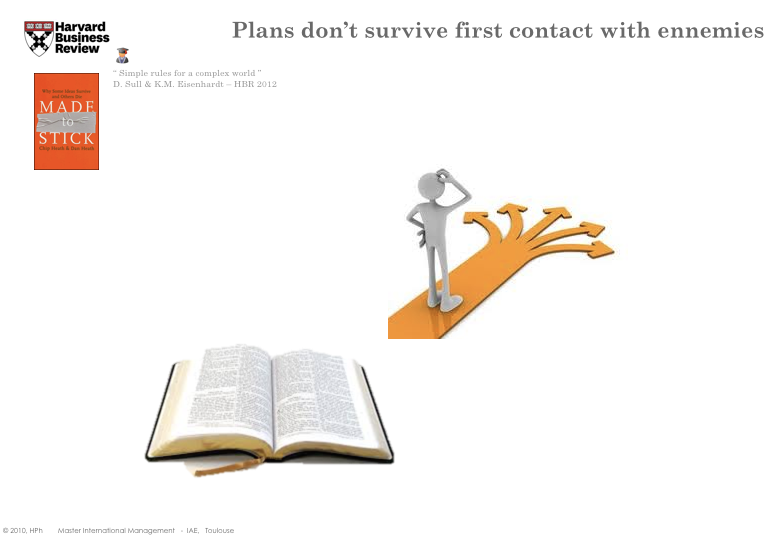Commander Intent
Even when it is explicitly formulated, a strategy does include detailed actions for all stakeholders. On the contrary, it should focus on top level considerations and ensure alignment, while leaving a lot of freeway to the people in charge of executing.

Organization alignment
D. Sull & K.M. Eisenhardt ( [Sull15] ) have rightly pointed out that if an organization’s strategy lives on the shelf then this organization has a problem. How to bridge the gap between strategy and execution? According to them, by polishing simple statements that help making on-the-spot decisions and adapting to rapidly changing circumstances
Indeed, they argue that while a checklist or any other process adherence technique is usually well adapted in repetitive situation (e.g. safety control) to ensure the activities alignment with corporate objectives. Agreeing on a simple ’principle’ is more adequate in more dynamic environment however, where flexibility is important. Process operators can then decide the most appropriate action to cope with the principle, subject to the actual circumstances.
In A.C. Hax’s words the true purpose [of the strategy statement] is to capture and clearly articulate our intent. Strategy is a fundamental vehicle to communicate our sense of direction, both inside and outside the organization. It aims to give purpose and direction to an organization and end up with the proper implementation of a well-designed strategy.
This simple idea of not trying to fix in advance every tiny detail was made famous by D. Eisenhower who claimed No plan survive the first contact with the enemy.

Chip & Dan Heath ( [Heath07] ) hammer on the message. The planning process forces people to think through the right issues, however even if you may start off trying to fight your plan, the enemy gets a vote.
In the 80’s the Army invented the concept of CI (Commander’s intend): a crisp, plain-talk statement, specifying the goal, the desired end-state. You can lose the ability to execute the original plan but you never lose the responsibility of executing the CI.
The commander’s intend should phrase something like if we do nothing else, we must : xxx or something like the single most important thing is: xx.
Compelling stories & Catch phrases
The hard part in producing such a statement is weeding out ideas that are important but not the most important. Finding the core is about discarding a lot of insights to let shine the most important insight. Consistently repeating a simple statement (or intent) is the best way to ensure that all the stakeholders in the organization receive the message and then make appropriate decisions.
Chip & Dan Heath quote this story from Herb Kelleher, the CEO of SouthWest : *„Tracy from marketing comes into my office and she says that surveys show that the passengers might enjoy a Cesar salad on the Houston to Las Vegas flight. What do you answer? You respond: Tracy, will adding that chicken salad make us THE low-cost airline from Houston to Vegas? Because if it doesn’t help us become the unchallenged low-cost airline, then we’re not serving any damn chicken salad.*” (Southwest’s CEO)
No one knows if there ever existed a Tracy in Southwest Marketing, but the story drives the point home: Southwest is THE low-cost company. Southwest has been very consistent in its intent over the years and has also been one of the only consistently profitable airline for more than 30 years.

Telling stories is also a way to make sure the staff can remember and feel the purpose of a strategic move. According to J. Conger ( [Conger08] ) Herb Kelleher used to tell the following story when visiting his operations across the United States: „It’s funny, I get letters all the time from shareholders and they’re often angry letters. They say : ’American West is flying between Los Angeles and Las Vegas for $149 one way. And you, Herb Kelleher at Southwest, are pricing $79 for that same one-way ticket. Don’t you have the decency to at least kick your price up to $129 ? Why are you leaving so much on the table ?’ Well, what I do is write and reply : Thank you so much for your letter. However you don’t understand who we are, and you really don’t understand who our competition is. It’s automobile; it’s not other airlines. And $79 is the price to drive, including maintenance, insurance and gasoline, from Los Angeles to Las Vegas. That’s how we price or ticket. ” (Southwest’s CEO)